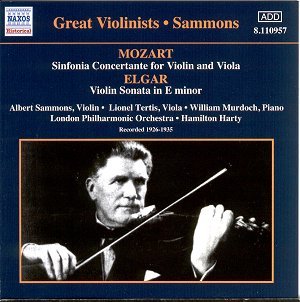Having been "brought up" on Sammons
and Tertis by my 78 rpm record collector friends, this disk comes
as a very welcome addition to the catalogue. The biggest surprise
will be Tertis’s first movement duo cadenza to the Mozart — interesting,
yes, but you’ll be happy to go back to Mozart’s own for every
day. The lush portamento sound of both soloists and orchestra
is to be expected and in my opinion a little of that today would
do no harm. Apart from these novelties, we have just a very fine,
good-sounding, vital, committed, performance of this music, one
well worth rescuing from the vaults. The sound is sweet, undistorted,
close-up, clear and realistic with plenty of bite in the solo
strings. Obert-Thorn has had success in reducing pitch variations
in the original source materials.
It had to be some happy accident of Sammons’
tone matching exactly the characteristics of the microphones of
that day that makes his recordings sound so good today. His famous
1932 recording of the Elgar Violin Concerto sounds better
than many 1950s LPs. These encore recordings of varying ages all
sound remarkably new and are very enjoyable to listen to, in contrast
to some archival issues. However they are not remarkable musically.
Sammons’ virtues lay in his intelligent musicianship, drama, and
sculptured long phrases, not in his virtuosity or flash. Hence,
you will surely find another version you prefer of all the violin
and piano ‘chestnuts’ recorded here.
Sammons’ own Bourée is the most
interesting in the list, but it’s not a particularly noble or
beautiful work. In the Sammartini/Nachez Passacaglia Sammons’
tone is not at its best. The lyrical phrases are lovely, and the
work is rare, so you will be happy to have this version, but his
scrapy triple stopping does not dazzle or amaze. His Meditation
and Londonderry Air are not sticky-sweet, and if
they aren’t, why play them at all? We want to hear Sammons play
these things out of affection and admiration for his other recordings,
and that’s a good reason.
His "other great Elgar recording" of
the Violin Sonata in e, of which Sammons and Murdoch early
became the definitive interpreters, sounds every bit as good and
up-to-date as the Concerto recording. This is certainly
the only version of this lovely work you will ever ‘need’ to own.
Paul Shoemaker

